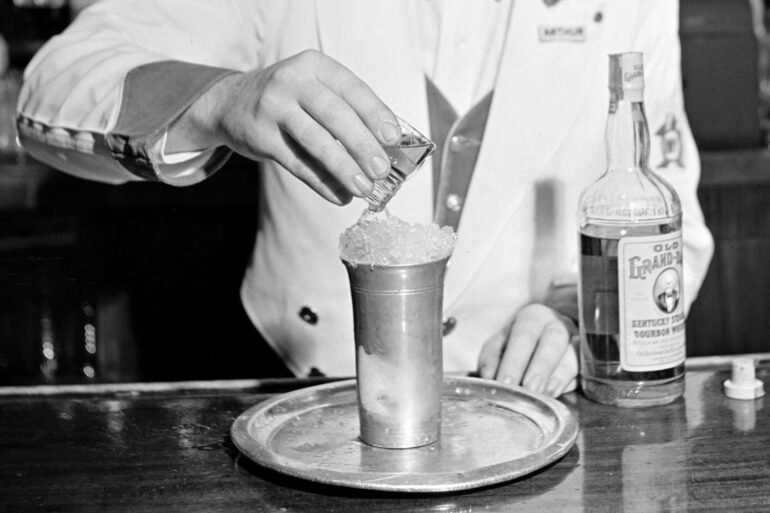:max_bytes(150000):strip_icc():format(jpeg)/How-Old-Grand-Dad-Went-From-Bottom-Shelf-to-Bartender-Favorite-FT-DGTL0925-01-dbddf2bc2f4e4279a727a2192e7ff83e.jpg)
Stalk the shelves and wells at your favorite bar, and you’ll likely see a familiar, orange-labeled bourbon staring back at you.
Old Grand-Dad isn’t new. In fact, it’s very old, as it debuted in 1882. But over the past decade, it’s experienced a renaissance led primarily by bartenders. They’ve enlisted this retro bourbon everywhere from high-end cocktail bars to lovable dives.
Old Grand-Dad, or OGD as it’s affectionately known, was created by Raymond B. Hayden. It was named for his grandfather, Basil Hayden Sr., whose visage appears on the label. The bourbon is part of the Beam portfolio, sports a high-rye mash bill, and is available in several expressions. The entry-level, 80-proof whiskey is an approachable and affordable introduction to the brand, available for about $20.
The 100-proof, bottled-in-bond bourbon and OGD 114 expressions turn up the potency and offer more developed flavors. Yet, they still retail at around $25 and $35, respectively. That’s a lot of bourbon for not a lot of money.
Dylan Ettinger
Why Bartenders love Old Grand-Dad
“OGD is a workhorse with great nuance and loads of spice and richness,” says Tristan Brunel, head of bars at The Ned Nomad in New York City. He credits its high rye content and says that the 100-proof expression is “perfect for a whiskey-based cocktail, as it can stand up to citrus, sugar, or other modifiers. That being said, it is also one of my favorite American whiskeys to enjoy alongside a beer or simply on its own, as it is equally delightful to sip on as it is to mix with.”
Joe Shirghio, beverage director of the group behind a handful of Dallas concepts that include Bowen House, Mike’s Gemini Twin, and St. Martin’s Wine Bistro, stocks multiple expressions of Old Grand-Dad. The 100-proof and 114-proof bottlings are favorites. He keeps the 80-proof in the well, as he finds it a versatile option that offers quality at a friendly price point.
Old Grand-Dad is among the bottlings known as a “bartender’s handshake,” similar to Mellow Corn or Fernet-Branca. It’s ordered often and generally revered by industry pros.
“My eyes light up when I go to a bar I’ve never been to and see it on the shelf,” says Shirghio. He likes to drink it straight, usually with a beer. However, he says it’s sought increasingly by consumers, who ask for it by name.
“When the 16-year came out, I thought it would be a pretty hard push, but people were like, ‘Wow, that’s the new Old Grand-Dad,’” says Shirghio.
Graphic House / Archive Photos / Getty Images
Old Grand-Dad vs. Basil Hayden
Dive deep enough down the OGD rabbit hole, and you’ll find whiskey heads and well-meaning conspiracy theorists who maintain that it’s essentially the same juice as the pricier Basil Hayden. That theory is grounded in reality. Both bourbons feature the same high-rye mash bill, but it doesn’t tell the full story.
Basil Hayden was introduced in 1992 by famed distiller Booker Noe. It was part of Jim Beam’s Small Batch collection, intended to offer a softer, subtler drinking experience than other products on the market. The flagship expression is 80 proof and doesn’t carry an age statement. Old Grand-Dad is bottled at multiple proofs, from 80 to 114. Two expressions — the new seven-year-old bottled-in-bond and the 16-year-old — have an age statement. The others do not.
Old Grand-Dad and Basil Hayden are aged in different barrels for different lengths of time, and they’re purposely produced with different flavor profiles in mind. Basil Hayden shows off more sweet oak and dried fruit, while Old Grand-Dad has a spicier nose, body, and finish.
“I see OGD as Basil’s younger sibling,” says Brunel, who finds it a bit punchier and slightly less polished than Basil Hayden. “I see this as a plus because it works better in cocktails, comes in at a much lower price point, and packs a ton of flavor for the money.” But it still has the backbone that Basil Hayden fans know and love.
Shirghio maintains that Old Grand-Dad has a bit more character than Basil Hayden and exhibits more of that rye spice. “Someone who is a fan of Basil Hayden but looking for something with a little more to it, will really like Old Grand-Dad,” he says.
Bartenders also favor OGD because it’s a stepping-off point to explore higher proofs in other expressions.
“Basil Hayden is only 80 proof, while OGD has the bonded and the 114,” says Shirghio. “The 114 is, bang for your buck, probably the best whiskey I can think of at just $35 or $40. It really blows people away.”
Bourbon’s collective popularity has skyrocketed over the past two decades, and certain brands have raised prices in kind. It’s nice to know that Old Grand-Dad — for now, at least — is still available at a fair value.
The next time you see OGD, keep it simple. Follow your bartender’s lead by ordering a shot and a beer. The combo works, even if you’re not coming off a 10-hour shift behind the bar.
Kevin Gray
2025-10-02 17:00:00

